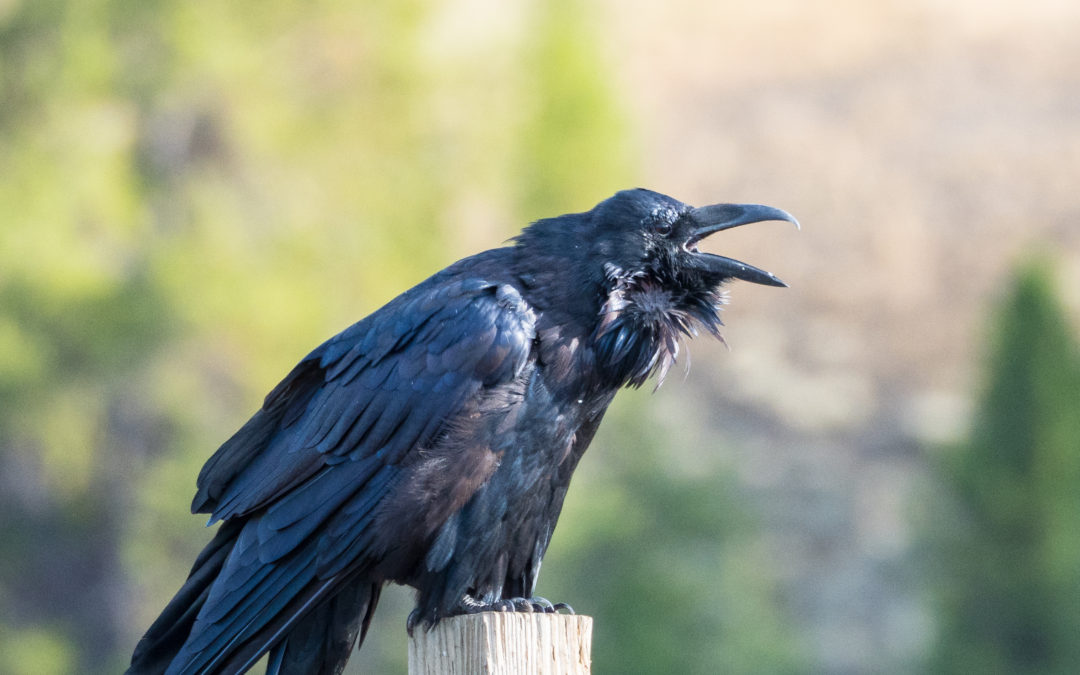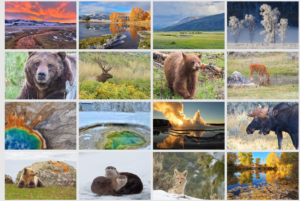Wild animals are communicating all around you. Here’s why you should start tuning in to animal language.
What if I told you there was an unbelievably rich world of animal language and communication happening around you all the time, yet unseen by most people? And what if I told you that anyone can tune in to this language and have a richer life for it? Tuning in to wild animal language is like pulling back the curtain and peeking into a secret world – one that can change your perspective and enrich your life beyond measure.
Stumbling upon a magpie funeral…
Six magpies burst into mid-air in a flicker-flash of black and white wings. Amid the fading calls and splayed, ebony tails, I am at a loss. A moment before I stumbled into this scene, a cacophony of squawking calls could be heard in this open meadow.
The vocalizations were odd, repetitive, and split the morning stillness like a polished steel wedge. My fragmentary look at this collection of iridescent birds—black-billed magpies—was of them all circled, shoulders nearly touching, with every beak pointing downward and in. As I walk up upon the focus of their gathering, my stomach twists in a knot.
The reason for their assembly is now clear; this was a funeral.
The things that animals do tell us a lot about their world and the environments that we share.
The simple position of a deer’s ears or the sounds the chickadees and squirrels are make are things we overlook a lot of the time, but in reality can convey tons of information.
Animals can hear, see, smell, and sense many things we can not—like dogs hearing high frequencies, bears smelling food from over a mile away and insects seeing ultraviolet light. These creatures are detecting things we never will, but we can get an idea of what they know by listening to the sounds they make and watching their behavior.
Tuning in animal language and discovering some of the things they perceive–and communicate about–can give us a lot of satisfaction and joy of being in their company, as well as connect us more deeply to the places we live and travel in.
The world is full of noise, and we have gotten exceedingly good at tuning it out, whether it’s the ambient sounds of the city, suburbia, or the country. Unfortunately, the notes of birds, mammals, and other creatures often get lumped into the din.
Once you realize that the proclamations of animals are not just sound, but communication, the equation shifts. You can now know things that seem like magic, if only you stop, look, and listen. Once you do, you’ll never be the same again.
Conversations among non-human beings are going on all of the time, and they have been going on for millions of years, long before there were humans to hear them. These communications are no less potent than the ones we can still hear today, we’ve just quit listening!
“Now wait,” I’m sure you’re thinking, “I love the outdoors, I bike, surf, I’m a fisherman, we camp, I’m a hunter, etc., and I pay attention. I’m sure if animals were talking and saying stuff, I’d know about it.” Sadly though, you’re not—I guarantee it.
In short, we’ve become unintentionally lazy. We’ve misused, abused, and neglected our senses and our ability to relate to non-human beings. For a few hundred thousand years (up until the last few centuries), observing the ear twitch of a deer, or the call of a bird, was as critical to your own life or death as thrusting a spear into the ribs of that evening’s dinner. Thus, you paid attention, you really paid attention.
Our innate senses: use ’em or lose ’em
As with so many things, you use it or you lose it. With humanity’s attention mired in Snapchat, 24-7 news feeds, talk radio, PTA meetings, bridge club gossip, 401K decisions and the details of the next Zoom meeting, etc, we’re stuck in a spin cycle of our own thoughts and emotions of the past, the future, but seldom of the present.
We’ve become largely deaf, dumb, and blind to the natural happenings around us. Whether it’s an urban, suburban, or wilderness setting, the messages are still being sent, but we’re just not picking up the phone. This has consequences.
Modern life has not only led us to ignore our innate gifts; it has also made us sick. In addition to keeping us safe, well-fed and medicated, today’s developed, westernized modus operandi also makes us depressed, angry, impatient, and self-absorbed.
Research confirming the latter also shows a light at the end of the tunnel: even small doses of outside time in a natural setting can be a game-changer. We need trees, grass, dirt, fresh air and clean water. And what is one of the best gateway drugs to kickstarting our renewed intake of “Vitamin N”, as Richard Louv coined it? You guessed it—animals.
Tune in to animal language and rediscover the real world
Becoming recalibrated to your surroundings by tuning in to animal language is not only informative and fun, but it is also transformative.
When you begin to recognize that these nonhuman beings are conveying information, sometimes very specific information, you can’t help but enter their world. The effect it has on our own experiences rotates our perspective. We see the world anew – through the eyes of the fox in the hedges, or the hawk circling above, or the squirrel chattering in the yard.
With mental health issues hitting so many of our communities, it is worth reminding ourselves that nature is a potent antidote. In the process of learning to listen to wild animals through their sounds, gestures, etc. we gain access to the real world, as it is meant to be. It is a reminder that this is our home too, one that can transport us away from our own silos of thought and emotion into something positive, even inspirational.
Seeing magpies differently
Nestled atop the long, cured grasses of autumn and sprinkled with a sugary coating of morning frost, is one of their kin. The magpies were drawn here to the remains of an elder. The extent of the white markings in the wing feathers clearly identifies the deceased as an adult; one they all likely knew and depended on for food and safety. With wings outstretched and its tail plumes folded up in a row, the dead magpie rests motionless. There is a single stem of grass held within its closed beak, not unlike an olive branch.
Though our reasons and responses may not be exactly the same, I look at magpies much differently now. Science has shown that birds and other animals have profound emotional lives and long-lived memories—remembering quite keenly who’s been naughty and nice.
What mankind has been dearly lacking over the past few centuries is a notion of how similar we really are to other species. When we tune in to animal language, we become more sensitive, more relaxed, and aware of truths such as this. A doorway has opened and the path beyond often leads to a place of inner peace.
How to start tuning in to animal language
We hope you’ll join a growing community of people inspired by the language of animals. Mother Nature needs us to rekindle our emotional attachment to her once again. Our quality of life depends on it and the ultimate survival of our global ecosystems hinges upon the choices we make. It is time to make wiser and more informed choices, and wisdom of this is best gained through direct contact. Tuning into the ‘wild ones’ in your area gives us a starting point to relate to the happening around the globe. We desperately need a renewed nature narrative, and this is exactly why you need to listen to animals. Listen to George talk about “why listen to animals” in this YouTube video.
If you want to reenter the conversations of nature, start with our free guide Animal Language: Five Things You Can Do Right Now to Tune In.
If you’re ready to take a deep dive, consider our online course “Eavesdropping on Wild Conversations: Decoding the Secrets of Animal Language for Ultimate Wildlife Encounters.”



